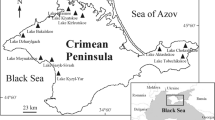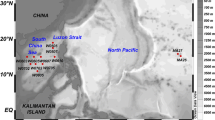Abstract
Radioactive waste disposal and nuclear testing concentrated in high latitudes in the northern hemisphere have resulted in the accumulation of radionuclides in Arctic marine ecosystems, but little is known of the consequences for marine biota in these waters. Under controlled laboratory conditions in May through September 1994, we examined the bioaccumulation in sea stars, Asterias forbesi (Desor), or the radionuclides 241Am, 57Co and 137Cs, all of which are important components of disposed radioactive wastes. Experiments at 2 and 12°C determined the relative importance of food (the bivalve, Macoma balthica) and water as sources of radionuclides and assessed the influence of temperature on radionuclide influx and efflux rates. The lower temperature greatly increased the retention of radionuclides ingested with food; for instance, the biological half-life (tb 1/2) of 241Am in the sea stars was 31 d at 12°C, but was virtually infinite at 2°C. Retention of ingested 57Co was also increased at 2°C (tb 1/2=41 d). 137Cs was not accumulated from food. Low temperature significantly reduced net influx rates of 137Cs from water, but did not affect net uptake of 241Am or 57Co. Temperature had little effect on the retention of all three isotopes obtained from the dissolved phase. These experiments suggest that extrapolation of results of previous radioecological studies, conducted at warmer temperatures, to polar or temperate winter environments may be problematic, and that nuclear waste isotopes obtained through trophic transfer may be retained far more efficiently in high latitude marine biota than by fauna from warmer ecosystems.
Similar content being viewed by others
References
Aarkrog A (1977) Environmental behavior of plutonium accidentally released at Thule, Greenland. Hlth Phys 32: 271–284
Aarkrog A (1994) Radioactivity in polar regions-main sources. J envirl Radioact 25: 21–35
Aarkrog A, Dahlgaard H, Nilsson K (1984) Further studies of plutonium and americium at Thule, Greenland. Hlth Phys 46: 29–44
Avery SV, Codd GA, Gadd GM (1992) Interactions of cyanobacteria and microalgae with caesium. In: Vernet J-P (ed) Impact of heavy metals on the environment. Elsevier, Amsterdam, pp 133–182
Binyon J (1976) The permeability of the asteroid podial wall to water and potassium ion. J mar biol Ass UK 56: 639–647
Bjerregaard P, Topçuo glu S, Fisher NS, Fowler SW (1985) Biokinetics of americium and plutonium in the mussel Mytilus edulis. Mar Ecol Prog Ser 21: 99–111
Chassard-Bouchaud C, Hubert M, Stampfler A, Abbé J-C, Galle P (1988) Bioaccumulations minérales chez Ophiothrix fragilis (Echinoderme: Ophiuride) de la Baie de Seine: étude par activation neutronique. C/r hebd Séanc Acad Sci, Paris 307: 249–257
Clarke A (1983) Life in cold water: physiological ecology of polar marine ectotherms. Oceanogr mar Biol A Rev 21: 341–453
Donnay G, Pawson DL (1969) X-ray diffraction studies of echinoderm plates. Science, NY 166: 1147–1150
Fisher NS (1986) On the reactivity of metals for marine phytoplankton. Limnol Oceanogr 31: 443–449
Fisher NS, Bjerregaard P, Fowler SW (1983) Interactions of marine plankton with transuranic elements. 3. Biokinetics of americium in euphausiids. Mar Biol 75: 261–268
Fowler SW, Baxter MS, Hamilton TF, Miquel J-C, Osvath I, Povinec PP, Scott EM (1994) International radiological assessment programs related to radioactive waste dumping in the Arctic Seas. Arct Res US 8: 92–100
Galey J, Goudard F, Pieri, J, Fowler SW, Carvalho FP (1983) Tissue and subcellular distribution of 252Cf and 241Am in the seastar Marthasterias glacialis. Mar Biol 75: 253–259
George RY (1981) Functional adaptations of marine organisms. In: Vernberg FJ, Vernberg WB (eds) Functional adaptations of marine organisms. Academic Press, New York, pp 279–332
Goudard F, Galey J, Pieri J, Fowler SW, Heussner S, LaRosa J (1985) Intracellular localization and binding of technetium-95m in the seastar Marthasterias glacilis. Mar Biol 85: 43–50
Guary J-C, Fowler SW, Beasley TM (1982) Routes of plutonium uptake and their relation to biomagnification in starfish. Mar Pollut Bull 13: 99–102
Guary J-C, Fowler SW, Beasley TM (1995) Environmental levels of americium-241 in two Mediterranean seastars. Rapp P-v Réun Commn int Explor scient Mer Mediterr 34: p 229
Hagen AA (1983) History of low-level radioactive waste disposal in the sea. In: Park PK, Kester DR, Duedall IW, Ketchum BH (eds) Wastes in the ocean. Vol. 3. Radioactive wastes and the ocean. Wiley, New York, pp 47–64
Hargrave BT (1986) Transfer of 241Am and 237Pu from euphausiid moults to carbonate-rich marine sediment. J envirl Radioact 3: 125–143
Hauge F (1993) Environmental problems in northern Russia: causes, consequences and solutions. In: Proc Workshop Arctic Contamination, US Interagency Arctic Research Policy, Committee, Anchorage
Hutchins DA, Teyssié JL, Boisson F, Fowler SW, Fisher NL (1996) Temperature effects on uptake and retention of contaminant radionuclides by the brittle star Ophiothrix fragilis. Mar envirl Res 41: (in press)
IAEA (1985) Sediment Kds and concentration factors for radionuclides in the marine environment. Tech Rept Series No. 247, International Atomic Energy Agency, Vienna
Mount ME, Sheaffer MK, Abbott DT (1994) Estimated inventory or radionuclides in former Soviet Union naval reactors dumped in the Kara Sea. Arct Res US 8 160–178
Park PK, Kester DR, Duedall IW, Ketchum BH (1983) Radioactive waste and the ocean: an overview. In Park PK, Kester DR, Duedall IW, Ketchum BH, (eds) Wastes in the ocean. Vol. 3. Radioactive wastes and the ocean. Wiley, New York, pp 3–46
Reinfelder JR, Fisher NS (1991) The assimilation of elements ingested by marine copepods. Science, NY 251: 794–796
Reinfelder JR, Fisher NS (1994) The assimilation of elements ingested by marine planktonic bivalve larvae. Limnol Oceanogr 39: 12–20
Santschi PH, Li Y-H, Adler DM, Amdurer M, Bell J, Nyffeler U (1983) The relative mobility of natural (Th, Pb and Po) and fallout (Pu, Am, Cs) radionuclides in the coastal marine environment: results from model ecosystems (MERL) and Narragansett Bay. Geochim cosmochim Acta 47: 201–210
Sokal RR, Rohlf FJ (1981) Biometry. WH Freeman, New York
Wang W-X, Fisher NS (1996) Assimilation of trace elements and carbon by the mussel, Mytilus edulis: effects of food composition. Limnol Oceanogr 41: 197–207
Zenkevitch L (1963) Biology of the seas of the U.S.S.R. Wiley Interscience, New York
Author information
Authors and Affiliations
Additional information
Communicated by J. P. Grassle, New Brunswick
Rights and permissions
About this article
Cite this article
Hutchins, D.A., Stupakoff, I. & Fisher, N.S. Temperature effects on accumulation and retention of radionuclides in the sea star, Asterias forbesi: implications for contaminated northern waters. Marine Biology 125, 701–706 (1996). https://doi.org/10.1007/BF00349252
Received:
Accepted:
Issue Date:
DOI: https://doi.org/10.1007/BF00349252




